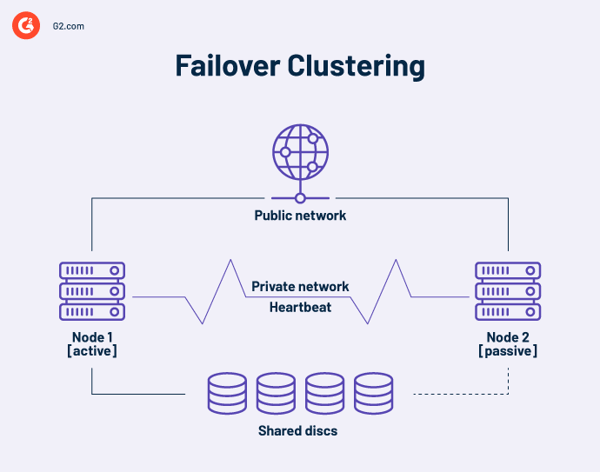[ad_1]
Firms that want on-line transactions can’t afford server breakdowns. Consequently, these companies search methods to create a failsafe process that retains their knowledge protected even when the server collapses. One such methodology is failover clustering.
Failover clustering could be ruled by managed area identify system (DNS) supplier options; nevertheless, understanding its mechanism and key options will help restrict any failover challenges.
What’s failover clustering?
Failover clustering operates on a bunch of pc servers to guarantee excessive availability (HA) or steady availability (CA) for server functions. This know-how ensures that if one server or node fails, one other cluster node stands able to take up the workload with out disruption.
This method retains your server workloads scalable and out there. Many main server applications, similar to Microsoft Alternate, Microsoft SQL Server, and Hyper-V, depend on failover clustering to guard themselves.
Some failover clusters make use of bodily servers, whereas others use digital machines (VMs). Everybody selects the type of cluster they want primarily based on the necessities of their server utility.
A cluster consists of two or extra nodes that change knowledge and software program to be processed by way of bodily cables or a specialised safe community. Clustering know-how of a number of varieties can be utilized for load balancing, storage, and concurrent or parallel computing. In some situations, failover clusters are mixed with further clustering applied sciences.
A failover cluster’s main operate is to offer CA or HA for functions and providers. CA clusters, also called failure tolerant (FT) clusters, let end-users proceed utilizing functions and providers even when a server fails. You may see a short interruption in service attributable to HA clusters, however the system can get better with no knowledge loss and little downtime.
Why is failover clustering essential?
With failover clustering, you may restore inactive nodes with out shutting down your database, avoiding downtime issues whereas shortly repairing damaged servers. Moreover, within the occasion of a {hardware} failure, this system terminates the database to guard the energetic nodes.
Failover clustering additionally automates knowledge restoration within the occasion of a failure. This reduces your reliance on the knowledge know-how (IT) crew and permits your servers to get better shortly. It additionally delivers glorious structured question language (SQL) cluster availability with minimal downtime. The automated failover performance of failover clustering preserves the operate of your database, even when there’s a {hardware} breakdown.
How do failover clusters work?
Failover clustering consists of two elementary processes, HA and CA, for server functions.
Whereas CA failover clusters attempt to attain 100% availability, HA clusters attempt for 99.999%, generally generally known as 5 nines. This downtime totals not more than 5.26 minutes annually. CA clusters have increased availability however require extra {hardware} to function, rising their general value.

Excessive availability failover clusters
A excessive availability cluster is a set of impartial computer systems that share assets and knowledge. A failover cluster’s nodes have entry to shared storage. A monitoring hyperlink can also be included in high-availability clusters to test the opposite servers’ heartbeat or well being. A heartbeat is a non-public community shared solely by the nodes within the cluster. It’s not accessible from the skin.
At any level, at the very least one node in a cluster is energetic, and at the very least one is dormant or passive.
In a fundamental two-node association, if Node 1 fails, Node 2 acknowledges the failure through the heartbeat connection and configures itself because the energetic node. Clustering software program on every node ensures shoppers connect with an energetic node.
Bigger installations could make use of devoted servers to manage the cluster. A cluster administration server at all times sends heartbeat alerts to determine any nodes failing and, in that case, to inform one other node to take up the work.
Some cluster administration software program instruments deal with HA for VMs by grouping the machines and servers right into a cluster. If a number fails, a unique host resumes the VMs.
As a doable single failure level, shared storage represents a danger. Nonetheless, combining a redundant array of impartial disks 6 and 10 – aka RAID 6 and RAID 10 – will help preserve service even when two laborious drives fail.
Electrical energy could be one other single level of failure if all servers are linked to the identical grid. Offering every node with its personal uninterruptible energy provide (UPS) retains them protected.
Steady availability failover clusters
In contrast to the HA paradigm, a fault-tolerant cluster contains quite a few computer systems that share a single copy of a pc’s working system (OS). Software program instructions given to 1 system are additionally executed on the opposite methods.
CA insists that the group employs formatted pc gear and a backup UPS. CA wants a always accessible and virtually good duplicate of the bodily or digital system working the service. This redundancy mannequin is named 2N.
CA methods can compensate for a variety of faults. A fault-tolerant system could determine a malfunction of:
- A tough disk drive
- A processing unit in a pc
- A subsystem for enter and output (I/O)
- An influence supply
- A part of a community
The failure level could also be found promptly, and a backup part or methodology can take its place instantly with out disrupting the subsequent service.
Clustering software program can join two or extra servers to behave as a single digital server or assemble varied various CA failover cluster configurations. For example, if one of many digital servers fails, the others reply by briefly eradicating the digital server from the cluster quorum. The digital server then redistributes the burden throughout the opposite servers till the crashed server is able to restart.
A double {hardware} server with all bodily elements replicated is an alternative choice to CA failover clusters. They compute individually and concurrently on varied {hardware} platforms and synchronize utilizing a devoted node that screens the outcomes from each bodily servers. Whereas this answer supplies safety, it might be costlier.
Failover clustering options
Many organizations use failover clustering for mission-critical functions. It is because the next traits make failover clustering a major method.
- Scalability: As a result of failover clustering is predicated on a bunch of clusters collaborating to stop server failure, you may simply and readily scale as wanted by including new clusters.
- Stability: Clustered servers join by way of wires. The remaining clusters can nonetheless provide service even when a number of fail on account of exterior components.
- Actual-time monitoring: The cluster nodes are always monitored to ensure they work correctly. When a cluster will get restarted or transferred onto one other node.
- Cluster shared quantity (CSV): This characteristic supplies a constant and distributed namespace for nodes to make use of whereas working with shared storage. It’s essential to maintain server functions working with out interruption from begin to end.
Sorts of failover clusters
Important developments in failover clustering have occurred within the final decade, with many organizations now providing their very own model of clustering options. Among the most typical cluster providers are detailed right here.
VMware failover clusters
VMware supplies quite a few virtualization applied sciences for VM clusters. The vSphere vMotion’s CA structure exactly duplicates a VMware digital machine and its community between bodily knowledge middle networks.
VMware vSphere HA, a second product, supplies HA for VMs by grouping them and their hosts right into a cluster for automated failover. Moreover, this system doesn’t depend on exterior elements similar to DNS, which lowers doable factors of failure.
Home windows server failover cluster
The Home windows server failover cluster (WSFC) methodology fosters the creation of Hyper-V failover servers. Between 2016 and 2019, this technique grew well-liked amongst Microsoft Home windows customers. WSFC permits cluster monitoring and provides the mandatory failover mechanism robotically. Within the occasion of a server loss, WFSC strikes the clusters to a separate node or makes an attempt to restart them. Moreover, its CSV know-how supplies a distributed namespace that enables a number of nodes to share reminiscence.
SQL server
This Microsoft product, launched with SQL Server 2017, has strong HA options that use WSFC know-how. SQL server elements are thought of WSFC cluster assets on this context. They’re additional built-in with different WSFC-dependent assets. Consequently, WSFC has authority over figuring out and speaking orders to restart a SQL server occasion or to maneuver situations like these to a brand new node.
Pink Hat Linux
Aside from Microsoft, different working system distributors include their very own failover cluster options. For instance, Pink Hat Enterprise Linux (RHEL) followers can use the HA extension and Pink Hat International File System (GFS/GFS2) to ascertain HA failover clusters. Single-cluster stretch clusters spanning many areas and multi-site, disaster-tolerant clusters are supported. Storage space community (SAN) knowledge storage replication is usually utilized in multi-site clusters.
Purposes of failover clustering
This strong mechanism facilitates the next real-time functions.
Availability of mission-critical functions.
On-line transaction processing (OLTP) computer systems should have fault-resistant methods. OLTP, which requires full availability, is used for airline reservation methods, digital inventory buying and selling, and ATM banking.
Many industries, similar to manufacturing, transport, and retail, make use of CA clusters or failure-resistant computer systems for mission-important functions. E-commerce, order administration, and workers time clock methods depend as examples.
Excessive availability clusters are sometimes acceptable for clustering functions and providers that require solely five-nines uptime.
Catastrophe reduction
Catastrophe restoration additionally advantages from failover clustering. It’s strongly really useful that failover servers be hosted at distant websites as a result of a calamity similar to a fireplace or flood destroys all bodily {hardware} and software program.
Storage Reproduction, a know-how that duplicates volumes between servers for catastrophe restoration, is included in Home windows Server 2016 and 2019. Stretch failover is a know-how characteristic that lets failover clusters span two areas.
Organizations can replicate knowledge over varied facilities by extending failover clusters. If tragedy strikes at one location, all knowledge is preserved on failover servers on the others.
Replication of a database
In response to Microsoft, the WSFC was first launched in Home windows Server 2016 to safeguard “mission-critical” providers, like its SQL server database and Microsoft Alternate communications server.
For database replication, different distributors provide failover cluster know-how. For instance, MySQL Cluster has a heartbeat methodology that allows quick failure detection to different nodes within the cluster, usually in beneath a literal second, with no service disruptions to shoppers.
Databases could also be replicated to faraway websites utilizing the geographic replication functionality.
Advantages of failover clusters
The concept of failover clusters is to make sure that customers expertise minimal disruptions in service. Nonetheless, different extra advantages of failover clustering are mentioned beneath.
- Elevated useful resource availability: If one clever server fails, the others within the cluster choose up the burden. This protects essential time and data.
- Strategic useful resource allocation: You get to distribute tasks between nodes in no matter method you select. This minimizes overhead since not all computer systems are required to execute all tasks concurrently, supplying you with a method to make use of your assets extra freely.
- Elevated processing energy: Extra machines, extra energy.
- Higher scalability: As your consumer base and report complexity broaden, so can your assets.
- Simplified administration: Clustering makes dealing with important or quick-changing methods simpler.
Limitations of failover clustering
As important as failover clustering is, it comes up in opposition to the next limitations.
- Advanced configurations: Failover clustering configuration for Home windows requires you to deal with many networks and community playing cards without delay. Consequently, deploying this methodology is troublesome, particularly for freshmen.
- Instrument integrations: Home windows failover clustering and Hyper-V have to be extra intently built-in. You need to regulate every of them to finish failover clustering efficiently.
- Internet interface: There’s no internet interface to regulate cluster parameters. To entry the cluster supervisor characteristic, you will need to manually log in to a distant desktop.
Failover clustering options: managed DNS suppliers
By working together with failover clustering methods, managed DNS suppliers redirect visitors to alternate servers or knowledge facilities throughout failover occasions, guaranteeing uninterrupted entry to your providers so that you obtain excessive availability and decrease downtime.
High 5 managed DNS suppliers:
* Above are the highest 5 main managed DNS suppliers software program from G2’s Fall 2023 Grid® Report.
Modernizing reliability
Failover clustering has emerged as a dependable and important choice for top availability and fault tolerance inside present IT infrastructures. It supplies ongoing operations regardless of {hardware} failures or scheduled upkeep by robotically spreading workloads and assets throughout quite a few networked nodes. This know-how offers you one other approach to deal with a very powerful facet of your corporation – making every buyer’s expertise protected and glad.
Fortifying your system’s resilience doesn’t damage, both!
Get began with a information to DNS safety for a strong system technique.
[ad_2]



